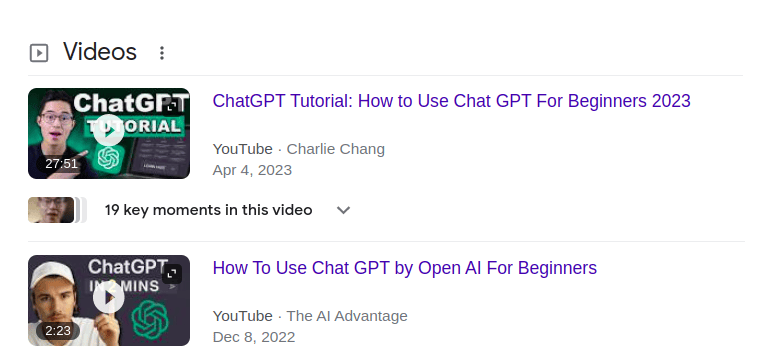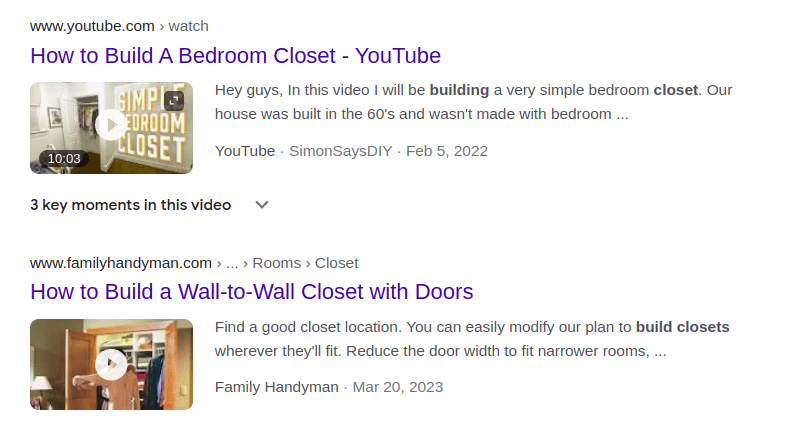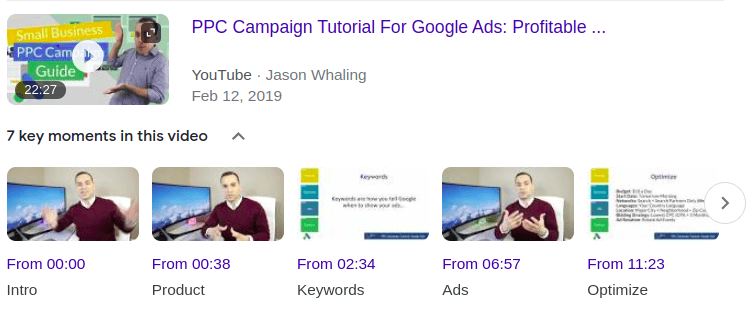Video SEO: How to Optimize Video Content for Search

Modern SEO is not simply optimizing your website’s internal structure. A huge part of search engine optimization is content marketing. With the help of producing great content, you can vastly expand your reach by ranking for informational queries.
SEO content marketing is often confined to creating blog posts and linkable assets like white papers, but content can also include videos. Videos can rank on Google’s search engine result pages and can help your site get more organic traffic.
In this article, we’ll take a look at how you can optimize your video pages for search and how it can help your business.
Chapters
How videos can increase your organic traffic
SEO video marketing, the process of optimizing your YouTube videos or videos embedded on a website page for SERP, can potentially bring more traffic to your business.
Firstly, this is because videos can appear in regular organic search results in the dedicated video snippet.

Source: Google
Not every keyword will have this snippet, though. But for keywords that do have a video snippet or look like they might have one in the future, your page can appear above the rest of organic search results.
Google has a separate section dedicated to searching videos, and users who are looking for videos specifically will find your site there.

Source: Google
Videos can also appear in the regular organic search results.

Source: Google
Having a video on your page doesn’t improve your chances of ranking higher, but it does something better. Since it’s clear from SERP results that your page has both text and a video, it might improve the click-through rate as more users will be interested in your content.
Having a video on your page can also mean users will spend more time there. This, together with the reduced bounce rate, can improve your website’s overall SEO. If your content is good, people will link to it, boosting your off-site SEO.
The only issue with video SEO is that if you look closely at a couple of video snippets, it mainly comprises links to different YouTube channels. If you want to dominate video search with better odds, you’d want to start a channel of your own and post videos on YouTube.
But to get your YouTube video ranking high in SERP, you’d likely have to have tens of thousands of subscribers and video views — not something easy to do fast. And these links won’t be doing any good directly for your site’s SEO.
So, if it’s video content SEO you’re going for, it’s best to host an animated video on your website page. That said, many of these tips on how to optimize video for search will work for both YouTube videos and for videos hosted on websites.
How to Create Videos with the help of AI
Creating videos with the help of AI is becoming increasingly popular, thanks to advanced tools that simplify the process. A smart way to scale SEO-optimized content is to convert video to document using AI, enabling you to repurpose engaging video footage into written blog content for greater organic reach. If you’re interested in producing your own AI-generated videos, here’s a step-by-step guide on how to do it using an AI video generator app:
Step 1: Choose the Right AI Video Generator App
Start by selecting an AI video generator that suits your needs. There are several options available, each with unique features such as automated editing, text-to-speech, and pre-built templates. Some popular AI video generators include Synthesia, Lumen5, and Descript. Consider what you need in terms of customization, ease of use, and output quality.
Step 2: Define Your Video Concept
Before you begin creating your video, it’s crucial to have a clear idea of what you want. Define the purpose of the video, your target audience, and the message you wish to convey. This will help guide the style and content of the video.
Step 3: Script and Storyboard
Develop a script that outlines what will be said in the video. If your video includes dialogue or narration, the AI can help generate or enhance this text. Additionally, creating a storyboard can help visualize the sequence of scenes, which is especially useful for complex videos.
Step 4: Upload and Input Content
With your script and concept ready, it’s time to upload any necessary media to the app, such as images, video clips, and voice clips. If you don’t have pre-existing media, some AI video generator apps can create visuals and audio based on your script alone.
Step 5: Customize with AI Features
Utilize the AI capabilities of your chosen app to enhance your video. This can include:
- AI-driven editing: Automatic cutting and editing based on the best practices for engagement and coherence.
- Text-to-speech: Transforming written script into spoken narration using realistic AI voices.
- Visual generation: Some apps can generate visual content based on textual descriptions, creating unique and relevant images or scenes for your video.
Step 6: Review and Edit
Once the AI has processed your inputs and generated the initial video, review it thoroughly. Most AI video generator apps allow you to tweak the video, such as adjusting timings, changing visuals, or reworking the narration. Make sure the final product aligns with your vision and message.
Step 7: Export and Share
After finalizing the video, export it from the app in your desired format and resolution. You can then share your AI-created video on social media, websites, or with your audience directly.
Tips for Effective AI Video Creation
- Keep it simple: Especially when starting out, keep your video concepts simple to ensure clarity and effectiveness.
- Focus on quality content: Even the best AI cannot compensate for a lack of substantive content. Ensure your script and visuals are engaging and valuable to your audience.
- Experiment with features: Take advantage of the unique features offered by your AI video generator app to explore creative ways of presenting your message.
Using an AI video generator app can dramatically streamline the video creation process, making it more accessible and efficient for creators at all levels. Whether for marketing, education, or entertainment, AI tools can help bring your video ideas to life with a professional touch.
How to optimize your video for SEO
Here are the nine most important factors influencing your video content SEO.
Make sure the video is available for Google
The first aspect is a purely technical one. The only way for Google to discover your page and then discover it has a video on it is to crawl it with a crawler bot. So, you want to make sure the page is not blocked from crawling in your site’s settings.
You can do that by double-checking that the page is not blocked from crawling by the robots.txt file and that the page’s HTML code doesn’t have a “noindex” meta tag. This way, you’re letting Google access your page and index it.
To make it easier for Google bots to understand there’s a video on your page, position it higher up on the page and make sure it covers the whole page topic. Smaller videos covering only a small part of your content might not be displayed in SERP.
The video should be loaded first on your page and should be accessible without logging in. Otherwise, Google may not show it on SERP. The video file in the HTML code is best to wrap in the appropriate tag like

A video embedded on a page will rarely rank on its own. Google generally operates with text on the page, so you’ll need to add some text to give context to the video. The best way to do that is to combine SEO video marketing with your blog and add a transcript of the video that can be read as an article.
This ensures that search engines have something to base their assumptions about the page on, and your users have multiple ways to consume your content.
Transcripts can also help search engines understand what a YouTube video is about. Here’s what a transcript looks like on this platform.
Auto-generated transcripts aren’t always completely accurate, so if you want to optimize videos fully, you might have to edit them a bit or use AI.
Find the right keywords
The next thing to do to optimize videos for search is to find the right keywords to optimize for. Sites and videos, for that matter, are found because they have good SEO — good on-page and off-page optimization that makes them visible to search engines. But they are found for specific search queries – keywords.
That’s why optimizing each page for a relevant keyword is just as essential as submitting sitemaps to Google.
You can find relevant keywords with the help of a keyword builder tool. A tool like this will analyze your site, find keywords you’re ranking for, and suggest more relevant ones. Ideally, you’d end up with a list of 1-5 keywords for each page that contains a video.
Focusing on one main keyword and a couple of supporting ones ensures your page will appear in search results for multiple keywords and increase traffic. With a short list of keywords for each page, you can improve your video SEO by adding them to the pages.
Create an engaging title and description
Your next step in SEO video marketing is creating SEO-friendly title and meta description tags. For video SEO purposes, you want these to contain your main keyword or a variation of it. To boost click-through rates, you want them to be engaging.
Both title and description are displayed on SERP, and users will decide whether to click on your video based on them. Make them interesting enough to encourage more users to click and watch your video.
The same goes for YouTube video titles and descriptions. On this platform, descriptions don’t have to be that huge. It’s enough that they contain your main keyword and can interest a user to watch the video.
If you want to speed up the creative process, use a YouTube description generator to create several descriptions options that can work for you.
Add a video transcript
A video embedded on a page will rarely rank on its own. Google generally operates with text on the page, so you’ll need to add some text to give context to the video. The best way to do that is to combine SEO video marketing with your blog and add a transcript of the video that can be read as an article.
This ensures that search engines have something to base their assumptions about the page on, and your users have multiple ways to consume your content.
Transcripts can also help search engines understand what a YouTube video is about. Here’s what a transcript looks like on this platform.
Auto-generated transcripts aren’t always completely accurate, so if you want to optimize videos fully, you might have to edit them a bit or use AI.
Create great thumbnails
Don’t rely on auto-generated thumbnails — those tend to be much more boring and unattractive than ones you can create yourself. Take photos for thumbnails or you can utilize a YouTube thumbnail maker to create custom illustrations to attract attention from users. This might influence CTR just as well as experimenting with your title because thumbnails are shown on SERP.
The best practice for video thumbnails is featuring a person displaying emotion. This appears to be the most attention-grabbing formula.
YouTube thumbnails can be added on the platform. Thumbnails for videos hosted on your website can be added via sitemap or structured data.
Work on on-page optimization
Overall optimization of your website can also impact your SEO video marketing efforts. You have to follow at least these best practices.
- Create easily understandable URLs. Ideally, they should contain a keyword.
- Link to the page containing the video from other pages of your site.
- Optimize videos for loading speed.
- Check the Core Web Vitals of the page and improve them.
Add structured data
Another thing you can do to optimize videos for SERP is add structured data to the pages hosting those videos. Structured data is used to display additional information about the video on SERP.
You can add it manually in the form of JSON code, as Google’s Structured Data Markup Helper doesn’t seem to work for marking up videos yet. After you add the code to the page, you can test whether you’ve marked everything correctly with Google’s Rich Results Test.
Add timestamps
One of the most important pieces of information you can add to your video is a timestamp. This helps video content SEO because key moments of your video will be displayed on SERP and might improve CTR. Adding timestamps to your video ensures viewers can find the exact content they’re interested in without any hassle. Using a YouTube timestamp generator can make this process faster and more efficient.

For a video hosted on your website, you’ll have to add a “Clip” object in structured data and specify the time frame for each clip you want to show on SERP.
Don’t rely on SEO only
The biggest advice for SEO video marketing is not to rely inclusively on SEO to promote your video. SERP is only one channel where your videos can be discovered, but you can also promote them on YouTube and social media.
If your goal is to boost the SEO of your website, adding videos to articles to improve CTR and give readers more ways to interact with your content is a great idea. But if you aim to promote a video you made, it’s best to promote it through different channels. To get a better understanding of the different approaches for attracting traffic and customers for your business, explore the article about inbound vs outbound marketing to learn how to maximize the benefit of your video content across different marketing channels.
Important SEO Factors for Video Marketing

Video marketing is no longer just a “nice-to-have.” It’s a cornerstone of any robust digital marketing strategy. Videos can captivate audiences, increase engagement, and, when optimized correctly, drive a significant amount of organic traffic. To maximize the benefits, you need to understand the key SEO factors that make your video content discoverable and impactful.
1. Choose the Right Platform for Your Videos
Where you host your videos can greatly influence their visibility. Platforms like YouTube and Vimeo are excellent for reach, but embedding videos directly on your site can boost on-page engagement metrics like time spent on site.
- YouTube Benefits: Its vast audience and powerful algorithm make it a go-to platform. Optimize video titles, descriptions, and tags for better rankings.
- Hosting on Your Website: If your priority is driving website traffic, hosting videos on your domain can improve SEO by reducing bounce rates and increasing session duration.
Consider your goals: Is it reach, conversions, or driving direct traffic? Your platform choice should align with your broader strategy.
2. Optimize Video Metadata
Metadata tells search engines what your video is about. Crafting this information thoughtfully ensures your content reaches the right audience.
- Title: Use keywords naturally and make it compelling. Think about how your audience searches for content.
- Description: Provide a detailed explanation of the video content. Include primary and secondary keywords, but avoid keyword stuffing.
- Tags: Use relevant tags that connect your video to similar topics, helping algorithms understand its context.
Metadata isn’t just for search engines; it also encourages clicks. A well-written title or description can be the difference between being overlooked or getting that crucial view.
3. Include Video Transcripts
Search engines can’t “watch” your video, but they can crawl its transcript. Adding a transcript not only boosts accessibility for your audience but also increases the likelihood of your video being indexed for relevant keywords.
For example, if your video discusses “top video marketing strategies,” having a transcript ensures phrases like this appear in search results, even if they’re spoken instead of written.
4. Create Eye-Catching Thumbnails
Your thumbnail is the first impression viewers get, and it plays a massive role in whether they click. A professional, visually appealing thumbnail with clear text and an engaging image can drastically improve click-through rates (CTR).
Ensure thumbnails are:
- Relevant to the content.
- High-quality and properly sized (e.g., 1280 x 720 for YouTube).
- Branded, when appropriate, to build recognition over time.
A thumbnail isn’t just decoration—it’s a hook. Don’t overlook its impact.
5. Prioritize Video Load Speed
Nobody likes a slow-loading video, and neither do search engines. Slow load times can negatively affect user experience and lead to higher bounce rates, which signals to search engines that your content isn’t worth ranking highly.
- Compress video files without sacrificing quality.
- Use a Content Delivery Network (CDN) to deliver content faster.
- Check your hosting service for speed capabilities.
Fast-loading videos not only keep viewers around but also send positive signals to Google about your site’s usability.
6. Focus on Mobile Optimization
With the majority of video consumption happening on mobile devices, ensuring your content is mobile-friendly is essential. Responsive design, fast-loading videos, and mobile-friendly platforms can make or break your video SEO efforts.
Test your videos on different devices and screen sizes to ensure a seamless experience.
7. Use Engaging CTAs
SEO isn’t just about bringing people to your video—it’s about driving action. Incorporate clear, engaging calls to action (CTAs) in your videos and descriptions.
Examples of CTAs include:
- Subscribing to your channel.
- Visiting your website.
- Downloading a resource or joining your email list.
CTAs guide viewers on what to do next, turning passive views into meaningful engagement.
8. Build Backlinks to Your Videos
Just like blog posts, videos benefit from backlinks. Share your videos across social media platforms, embed them in blog posts, and encourage others to link to them. The more quality backlinks your video content earns, the better its chances of ranking well.
9. Monitor Analytics and Adjust
SEO isn’t a set-it-and-forget-it process. Use tools like Google Analytics and YouTube Analytics to track your video performance. Pay attention to metrics such as:
- Watch time.
- Engagement rate (likes, comments, shares).
- Traffic sources.
Identify what works and double down on it. If a certain type of video is resonating with your audience, create more of it!
10. Consistency is Key
One viral video might give you a temporary traffic spike, but long-term success requires consistency. Regularly publish optimized, high-quality videos that align with your audience’s needs. Over time, this builds authority and keeps your audience coming back for more.
Video marketing and SEO go hand in hand. By optimizing your platform choice, metadata, thumbnails, load speed, and more, you can maximize your video’s visibility and engagement. Remember, the key is to provide value. Create content that informs, entertains, or inspires—and the SEO benefits will follow naturally.
Now, it’s your turn. What’s your next video about?
Summary
Working on your video content SEO can be a great way to improve your existing SEO results. SEO video marketing efforts can also be an essential part of your content marketing strategy. Either way, it can boost traffic to your online assets and increase sales.
Follow these tips to make sure your videos appear on SERP, and test different variants of titles, descriptions, and thumbnails to improve CTR.
FAQ
What is Video SEO?
Video SEO refers to the process of optimizing video content to improve its visibility and ranking in search engine results pages (SERPs). It involves optimizing various elements such as titles, descriptions, tags, and metadata to make videos more discoverable to users.
Why is Video SEO important?
Video SEO is important because it helps videos rank higher in search results, increasing visibility and driving more organic traffic to your content. Optimized videos are more likely to be seen by your target audience, leading to higher engagement and conversions.
What are some key factors to consider when optimizing videos for search engines?
Key factors to consider when optimizing videos for search engines include keyword research, optimizing video titles and descriptions, using relevant tags and categories, creating high-quality content, and optimizing video thumbnails and captions.
How can I optimize video titles for better SEO?
Optimize video titles for better SEO by including target keywords, keeping titles concise and descriptive, and using compelling language to attract clicks. Front-load important keywords and place branding or episode numbers at the end of titles.
What role do video descriptions play in Video SEO?
Video descriptions provide valuable context to search engines and viewers, helping them understand the content of your videos. Include relevant keywords and phrases in descriptions, provide links to related content, and add timestamps for easy navigation.
How can I optimize video tags for improved visibility?
Optimize video tags by using relevant keywords and phrases that accurately describe the content of your videos. Use a mix of broad and specific tags, include variations of your target keywords, and incorporate tags related to your industry or niche.
What are some best practices for optimizing video thumbnails?
Best practices for optimizing video thumbnails include using high-quality images that accurately represent your content, incorporating text or branding to make thumbnails more engaging, and testing different thumbnail designs to see what resonates best with your audience.
How can I make my videos more accessible for search engines and users with disabilities?
Make your videos more accessible by adding closed captions or subtitles, providing transcripts for audio content, and optimizing video metadata with descriptive language. Accessible videos are more likely to rank well in search results and reach a wider audience.
What role does video engagement play in Video SEO?
Video engagement metrics such as watch time, likes, comments, and shares are important signals that indicate the quality and relevance of your content to both users and search engines. Encourage viewer engagement by creating compelling videos that resonate with your audience.
How can I measure the success of my Video SEO efforts?
Measure the success of your Video SEO efforts by tracking key metrics such as video views, watch time, click-through rates, and rankings in search results. Analyze performance data regularly to identify areas for improvement and optimize your video strategy accordingly.
How does hosting platform choice impact Video SEO?
The hosting platform choice can impact Video SEO by affecting factors such as video load times, compatibility with search engine algorithms, and the availability of built-in SEO features. Choose a hosting platform that prioritizes video SEO best practices and provides tools for optimization.
What role do video transcripts play in Video SEO?
Video transcripts play a significant role in Video SEO by providing text-based content that search engines can crawl and index. Including transcripts alongside videos can improve accessibility, keyword relevance, and overall SEO performance.
How can I optimize video titles for different platforms?
Optimize video titles for different platforms by tailoring them to each platform’s character limits, audience demographics, and search algorithms. Customize titles to align with platform-specific trends and formatting preferences while maintaining consistency with your brand messaging.
Can video schema markup improve Video SEO?
Yes, video schema markup can improve Video SEO by providing search engines with structured data about your video content, including information such as titles, descriptions, durations, and thumbnails. Implementing video schema markup can enhance search result appearance and click-through rates.
How can I promote video engagement to boost Video SEO?
Promote video engagement by encouraging viewers to like, comment, share, and subscribe to your videos. Respond to comments, ask questions, and create interactive elements within your videos to foster community engagement and signal quality to search engines.
What role does video quality and production value play in Video SEO?
Video quality and production value can impact Video SEO by influencing user engagement, retention rates, and brand perception. Investing in high-quality production, clear audio, and visually appealing content can improve viewer satisfaction and SEO performance.
How can I leverage video playlists for Video SEO?
Leverage video playlists for Video SEO by organizing related videos into thematic collections that encourage binge-watching and longer viewing sessions. Optimize playlist titles, descriptions, and thumbnails to improve visibility and navigation for both users and search engines.
What strategies can I use to optimize video descriptions for SEO?
Optimize video descriptions for SEO by providing detailed summaries of video content, including relevant keywords and phrases, and adding links to related content or resources. Use natural language and formatting to enhance readability and search engine visibility.
How does social sharing impact Video SEO?
Social sharing can impact Video SEO by increasing video visibility, driving traffic, and generating backlinks from social media platforms. Encourage viewers to share your videos on social networks to amplify reach and engagement, which can positively influence search rankings.
Should I optimize video file names for SEO, and if yes, how?
Yes, optimizing video file names for SEO can improve search engine visibility by including relevant keywords and descriptive phrases. Use hyphens to separate words and avoid generic file names to provide context and improve indexing for search engines.
Interesting articles
- The Ultimate Guide to Boosting Your Earnings Through Partnerships
- How AI and Virtual Talent Are Changing Content Creation
- How SEO Drives Real Business Growth in 2025
- Building Your Brand: Integrating Your Domain Name with Your Marketing Strategy
- The Corporate Events of the Future: 5 Trends That Are Revolutionising the Industry
- Is Someone Impersonating Your Brand Online? Tips to Spot Domain Doppelgangers
- How to use UTM Codes To Determine the Origin of Your Traffic
Master the Art of Video Marketing
AI-Powered Tools to Ideate, Optimize, and Amplify!
- Spark Creativity: Unleash the most effective video ideas, scripts, and engaging hooks with our AI Generators.
- Optimize Instantly: Elevate your YouTube presence by optimizing video Titles, Descriptions, and Tags in seconds.
- Amplify Your Reach: Effortlessly craft social media, email, and ad copy to maximize your video’s impact.